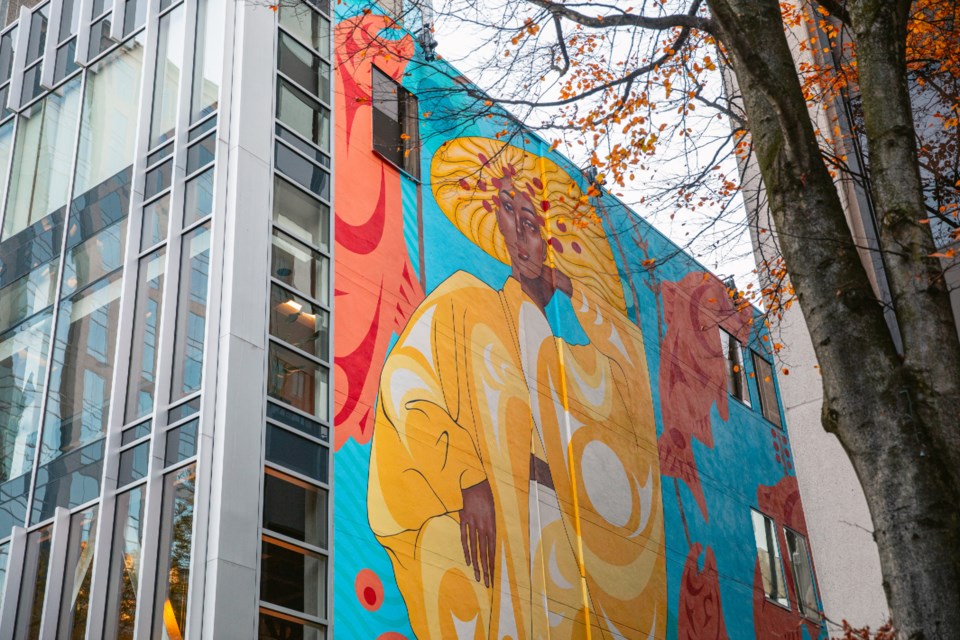A formerly grey, lifeless laneway in Downtown Vancouver now looks as bright as the sun, with a feast of colours and a striking design inspired by a traditional Squamish Nation story.
snékwem, or “the sun” lane, can be seen between Granville and Pender Streets and is the latest laneway transformation project managed by the Downtown Vancouver Business Improvement Association. It’s part of a larger initiative called Re-Imagine Downtown Vancouver, aiming to create more inclusive experiences and spaces in the city over the next 25 years.
The huge 6,500-square-foot masterpiece was created by North Vancouver artists Lauren Brevner, a Japanese-Trinidadian mixed-media portrait artist, and James Harry, an Indigenous artist and sculptor. The colourful mural was painted in October and launched to the public mid-November.
The multi-disciplinary artists have been working together for six years now and have collaborated on several mural projects – but this is their biggest one yet.
The mural is so massive, it took about 14 days to paint, and the duo even enlisted four interns to help bring the wall alive.
The laneway's design features Brevner and Harry’s modern interpretation of a Squamish Nation story about how the salmon came to Squamish waters.
The story was passed down to Harry – who is of Sḵwx̱wú7mesh and Namgis decent – by his father, Xwalacktun, and speaks of visitors with supernatural powers who, with the help of snéḵwem, led the Squamish people to the village of the salmon people.
“Before we even begin designing, we try and figure out what we want to say through our work because we’re painting murals in a very public space, and it’s a really great opportunity to introduce the public to the history of the Skwxwú7mesh people,” said Harry.
“This mural, and really a lot of murals we’ve done thus far, have been about retelling traditional stories from our perspective and putting our own artistic twist on them,” added Brevner.
Choosing a story to feature comes down to which “hits closer to home for that area” for the artists.
“Vancouver specifically is part of the territory of Squamish Nation, so highlighting some of their stories really gives a sense of place back to Squamish people but also educates others on the First Peoples of the land,” said Harry.
With its bright colours of blue, yellow, and salmon-red, it can’t be missed by passersby.
“We don’t normally work with that kind of colour pallet, but we wanted to bring some bright, vibrant colours to the alley, so it didn’t feel so dark and weary,” said Harry.
“We wanted people to feel comfortable.”
The design’s focal point is a 50-foot feminine figure personifying the spirit of snéḵwem and seven kwu7s (chinook) salmon, which are the first salmon species to run every year. Seven is also a significant number for Indigenous people as it represents the Seventh Generation Principle: a philosophy that the actions we make now impact the future seven generations.
For Brevner, being able to look up at the woman they’ve painted on the wall means a lot.
“The mural industry is a very male-dominated space, and for me, it’s a huge accomplishment to be a woman in this field,” she said.
“My work is all about representation, and I think that there should be more women represented on walls, and in general, and, also, women of colour represented.”
Every chance she gets, she’s painting female figures, hoping her work will send a stronger message to younger generations.
“Seeing such a strong and extremely large woman painted on the side of this building – I think there’s a level of subconscious that’s going to hit younger people that feel that they’re being represented,” explained Brevner.
“I hope it is inspiring for them.”
Their other murals can be found at Granville Island, at Thurlow and West Pender streets, and West Broadway and Arbutus Street. Their fine artwork will also be on display at the Vancouver Art Gallery this winter.
snékwem lane is the DVBIA's fourth laneway transformation, said Charles Gauthier, president, and chief executive officer of the association.
“The DVBIA is dedicated to showcasing more Salish art within downtown public spaces,” he said.
“Laneways have a vast amount of untapped potential, and our transformation projects use art to brighten and animate a nondescript space that further encourages people to explore downtown.”
Previous projects include Alley Oop, a bright, pink and yellow alleyway just off of Hastings and Granville; Ackery's Alley, an outdoor performance space featuring an interactive light and sound installation adjacent to the Orpheum Theatre; and Canvas Corridor, in Eihu lane between Alberni and Robson streets, highlighting forty-five doorways and vents wrapped with artwork from local artists.
There will also be a plaque at snékwem lane which shares the Squamish Nation story.



